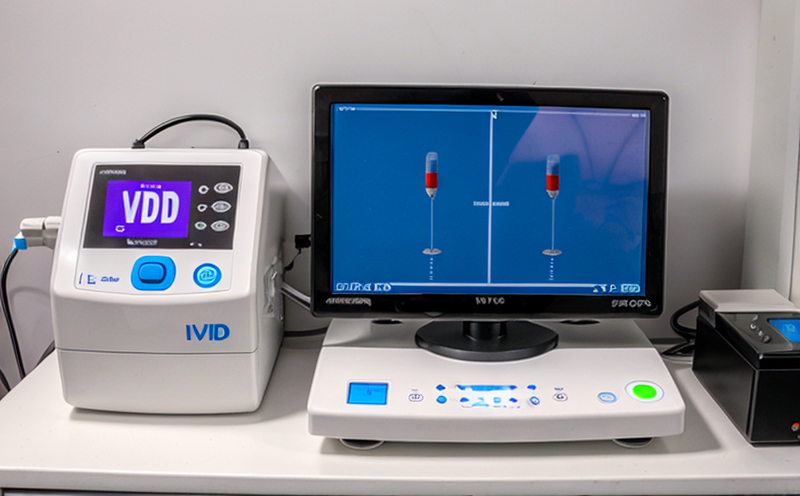CLSI EP06 Linearity Testing for IVD Analytical Systems
The CLSI (formerly known as the Clinical and Laboratory Standards Institute) EP06 document provides comprehensive guidelines on how to perform linearity testing for in vitro diagnostic (IVD) analytical systems. This service is critical because it ensures that IVD devices provide consistent and accurate results across a wide range of analyte concentrations, which directly impacts patient outcomes and clinical decision-making.
Linearity testing is a key component of method validation and quality assurance programs. According to CLSI EP06, linearity testing should be conducted under the conditions intended for use by laboratories. This includes both the lower limit of quantitation (LLOQ) and upper limit of quantitation (ULOQ). The purpose is to demonstrate that the device can accurately measure analyte concentrations across this range.
During a CLSI EP06 linearity test, various specimens are prepared with known concentrations of the analytes being measured. These specimens then undergo testing using the IVD analytical system in question. The results from these tests are compared to the expected values derived from the calibration curve. If the observed and expected results align closely within predefined acceptance criteria, the device passes linearity testing.
The precision and accuracy of an IVD device’s performance is paramount for reliable patient care. By adhering to CLSI EP06 guidelines, laboratories can ensure that their analytical systems meet stringent standards set forth by regulatory bodies such as the FDA (US), EMA (EU), and other international organizations. This service helps maintain compliance with these regulations while also enhancing confidence in laboratory results.
It’s important to note that linearity testing is just one part of a broader process that includes calibration, verification, and validation. Together, these steps form the backbone of quality assurance programs designed to protect patient safety and improve healthcare delivery.
- Precision: Ensures consistent results over time and between different runs.
- Accuracy: Guarantees that measured values reflect true analyte concentrations accurately.
- Trueness: Refers to the agreement of a measured value with the true value. It’s closely related to accuracy but focuses more on systematic errors rather than random ones.
- Certainty: Provides assurance that tests will yield reliable results consistently and reliably across various conditions.
Understanding these concepts is crucial for interpreting linearity test results correctly. Precision, accuracy, trueness, and certainty all contribute to overall performance metrics which are essential for maintaining high-quality standards in medical diagnostics.
The CLSI EP06 document outlines specific procedures for conducting linearity tests that take into account factors such as sample preparation, instrument settings, reagent stability, and environmental conditions. Adhering strictly to these protocols ensures consistent results regardless of who performs the test or where it’s conducted. This consistency is vital when comparing results from different laboratories or over extended periods.
By leveraging CLSI EP06 guidelines in linearity testing, laboratories can demonstrate compliance with regulatory requirements and enhance trust among healthcare providers and patients alike. The rigorous nature of this service underscores its importance in ensuring accurate diagnoses and effective treatment strategies across diverse clinical settings.
Why It Matters
The accuracy and reliability of IVD analytical systems are fundamental to the practice of medicine. Patients rely on these devices for precise measurements that guide their diagnosis and treatment plans. Any deviation from expected results could lead to misdiagnosis or inappropriate therapy, potentially resulting in adverse health outcomes.
Compliance with CLSI EP06 standards ensures that IVD devices meet stringent performance criteria, thereby enhancing the confidence of healthcare professionals who rely on these tools daily. This compliance not only satisfies regulatory requirements but also fosters a culture of continuous improvement within laboratories and healthcare institutions.
In addition to improving patient care, adhering to CLSI EP06 helps protect against liability issues associated with inaccurate or unreliable test results. When laboratories consistently perform thorough linearity tests according to established protocols, they reduce the risk of errors that could arise due to improper calibration or other technical issues.
The broader impact extends beyond individual institutions; it contributes to the overall quality and reliability of diagnostic services across entire healthcare systems. By ensuring consistent performance among various IVD devices used in different laboratories, CLSI EP06 plays a crucial role in promoting best practices throughout the industry.
Quality and Reliability Assurance
- Consistent Results: Ensures that tests yield similar results across different days, operators, and instruments.
- Precision: Minimizes the variability of test results within a given set of conditions.
- Accuracy: Guarantees that measured values closely match true analyte concentrations.
- Trueness: Ensures agreement between measured values and reference standards.
- Certainty: Provides assurance about the reliability and reproducibility of test results.
These aspects are critical for maintaining high-quality diagnostic practices that contribute significantly to patient safety and effective treatment strategies. Compliance with CLSI EP06 ensures that IVD devices perform consistently across various conditions, thereby enhancing the overall reliability and trustworthiness of these systems.
Environmental and Sustainability Contributions
In vitro diagnostic (IVD) testing plays a vital role in modern healthcare by providing accurate information necessary for diagnosing diseases and guiding therapeutic interventions. However, it’s essential to consider the environmental impact associated with these tests, particularly when conducting linearity tests.
The CLSI EP06 guidelines emphasize the importance of minimizing waste generation during IVD testing processes. By optimizing sample preparation methods and using efficient calibration procedures, laboratories can reduce the amount of reagents, disposables, and other consumables required for each test run. This not only reduces operational costs but also contributes positively to environmental sustainability efforts.
Moreover, adhering to CLSI EP06 helps ensure that IVD devices operate efficiently under standard laboratory conditions. Proper calibration ensures that instruments consume less power while maintaining optimal performance levels. Additionally, by reducing the frequency of recalibrations needed due to improper use or poor maintenance practices, laboratories can extend the lifespan of their equipment, further promoting sustainability.
Overall, implementing CLSI EP06 linearity testing protocols supports both quality assurance initiatives and environmental stewardship goals within healthcare settings. Through careful planning and execution, laboratories can balance operational efficiency with ecological responsibility, contributing to a more sustainable future in medical diagnostics.





